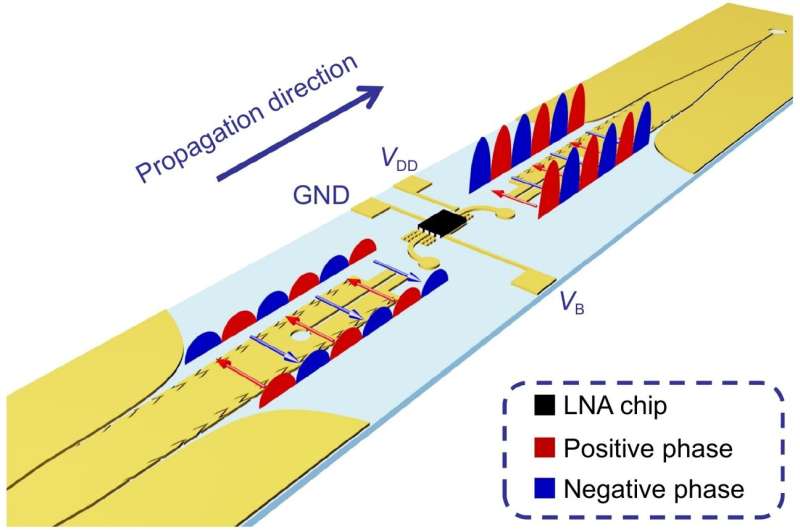Active odd-mode-metachannel provides a new avenue to future single-conductor systems

A new publication from Opto-Electronic Advances discusses how active odd-mode-metachannel can provide a new avenue to future single-conductor systems.
Planar single-conductor circuit studies have involved tremendous efforts. However, providing tight electromagnetic field confinement and compatibility with active semiconductors remains challenging. SSPP structures do not integrate well with active semiconductor components. Researchers have proposed a new OMM that supports odd-mode SSPPs for single conductor systems. Zigzag decoration can strengthen field confinement and broaden bandwidth. The proposed OMM and integrative properties may provide new avenues for future single-conductor conformal systems and smart skins.
Modern planar circuits and systems combine multi-conductor transmission media and active semiconductor components. However, typical multi-conductor transmission media usually require a large metallic ground. One limitation is that large metallic surfaces make the circuit too rigid to construct flexible or soft systems. A second challenge is that large metallic surfaces increase the system's radar cross section (RCS).
To solve the problems, exploring compact single-conductor transmission media without large metallic ground is a possible path. The underdevelopment of single-conductor systems compared to multi-conductor ones is caused by insufficient electromagnetic field confinement and poor compatibility with the active semiconductor technology of single-conductor media. Mature active semiconductor components require signal input in the form of voltage.
Spoof surface plasmon polaritons (SSPPs)are a special type of surface wave. It can mimic the optical natural surface plasmon polaritons (SPPs). Both single-conductor and multi-conductor plasmonic metamaterials can support SSPPs in the microwave and terahertz bands. Ultra-thin SSPP structures possess many merits in microwave and terahertz engineering. Based on these merits, SSPPs are utilized to realize a series of novel devices. They include filters, modulators, antennas, and even landmark systems such as wireless body sensor networks and wireless communication systems.
Multi-conductor ultra-thin SSPP technology has grown. The landmark achievement of sub-diffraction-limited signal wireless communication carried by the multi-conductor SSPP system demonstrates the superiority of SSPPs. Nevertheless, multi-conductor ultra-thin SSPP technology provides no advantages in breaking the two limitations of multi-conductor transmission media.
Although single-conductor SSPPs possess the ability of field confinement and conformal propagation, they are still far from systematic applications. There is no good method to integrate key active semiconductor components such as amplifiers into single-conductor SSPP circuits. Seeking a feasible technique to solve the problems of multi-conductor transmission media and break the bottleneck of single-conductor transmission media simultaneously is still urgent.
The research team propose a new kind of odd-mode-metachannel (OMM) for single-conductor systems. They firstly analyze the potential of active semi-conductor-component integration. The team then assessed the basic design principles behind the OMM to strengthen field confinement and broaden bandwidth simultaneously. Utilizing the odd-mode field potential difference of the OMM achieved the single-conductor amplifier integrated with the OMM.
The proposed method can be extended to almost all active semiconductor components in microwave and terahertz systems. The team demonstrated the merits of crosstalk suppression based on odd-even-mode orthogonality, low RCS and the OMM's flexibility. Hence, the proposed OMM may overcome the obstacles of realizing single-conductor systems and provide one more avenue to future smart skins.
The new odd-mode-metachannel performs as the fundamental transmission medium for a single-conductor system. Introducing zigzag decorations onto the SSPP structure resolves the tradeoff of bandwidth and field confinement of odd-mode SSPPs. It is possible to utilize an odd-mode field to excite active semiconductor components.
In conclusion, the proposed OMM and the method of active semi-conductor-component integration remove the major obstacles to realizing conformal single-conductor systems and provide an avenue for future smart skins.
More information: Pei Hang He et al, Active odd-mode-metachannel for single-conductor systems, Opto-Electronic Advances (2022). DOI: 10.29026/oea.2022.210119
Provided by Compuscript Ltd



















